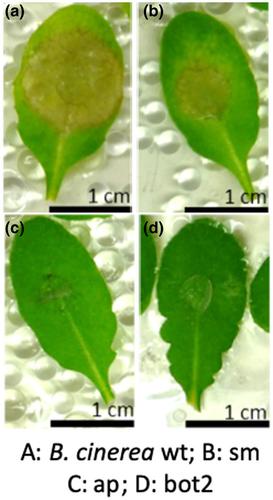当前位置:
X-MOL 学术
›
Mol. Plant Pathol.
›
论文详情
Our official English website, www.x-mol.net, welcomes your
feedback! (Note: you will need to create a separate account there.)
Plant nitrogen supply affects the Botrytis cinerea infection process and modulates known and novel virulence factors.
Molecular Plant Pathology ( IF 4.8 ) Pub Date : 2020-09-17 , DOI: 10.1111/mpp.12984 Marie-Christine Soulie 1, 2 , Shamsuddin Mia Koka 2 , Kévin Floch 2 , Baptiste Vancostenoble 2 , Deborah Barbe 2 , Antoine Daviere 2 , Ludivine Soubigou-Taconnat 3, 4 , Veronique Brunaud 3, 4 , Nathalie Poussereau 5 , Elise Loisel 5 , Amelie Devallee 5 , Dominique Expert 2 , Mathilde Fagard 2
Molecular Plant Pathology ( IF 4.8 ) Pub Date : 2020-09-17 , DOI: 10.1111/mpp.12984 Marie-Christine Soulie 1, 2 , Shamsuddin Mia Koka 2 , Kévin Floch 2 , Baptiste Vancostenoble 2 , Deborah Barbe 2 , Antoine Daviere 2 , Ludivine Soubigou-Taconnat 3, 4 , Veronique Brunaud 3, 4 , Nathalie Poussereau 5 , Elise Loisel 5 , Amelie Devallee 5 , Dominique Expert 2 , Mathilde Fagard 2
Affiliation

|
Plant nitrogen (N) fertilization is known to affect disease; however, the underlying mechanisms remain mostly unknown. We investigated the impact of N supply on the Arabidopsis thaliana–Botrytis cinerea interaction. A. thaliana plants grown in low nitrate were more tolerant to all wild‐type B. cinerea strains tested. We determined leaf nitrate concentrations and showed that they had a limited impact on B. cinerea growth in vitro. For the first time, we performed a dual RNA‐Seq of infected leaves of plants grown with different nitrate concentrations. Transcriptome analysis showed that plant and fungal transcriptomes were marginally affected by plant nitrate supply. Indeed, only a limited set of plant (182) and fungal (22) genes displayed expression profiles altered by nitrate supply. The expression of selected genes was confirmed by quantitative reverse transcription PCR at 6 hr postinfection (hpi) and analysed at a later time point (24 hpi). We selected three of the 22 B. cinerea genes identified for further analysis. B. cinerea mutants affected in these genes were less aggressive than the wild‐type strain. We also showed that plants grown in ammonium were more tolerant to B. cinerea. Furthermore, expression of the selected B. cinerea genes in planta was altered when plants were grown with ammonium instead of nitrate, demonstrating an impact of the nature of N supplied to plants on the interaction. Identification of B. cinerea genes expressed differentially in planta according to plant N supply unveils two novel virulence functions required for full virulence in A. thaliana: a secondary metabolite (SM) and an acidic protease (AP).
中文翻译:

植物氮的供应影响灰葡萄孢的感染过程,并调节已知和新的毒力因子。
已知植物氮肥会影响疾病。但是,其基本机制仍然未知。我们调查了氮供应对拟南芥-灰葡萄孢相互作用的影响。在低硝酸盐条件下生长的拟南芥植物对所有测试的野生型灰葡萄孢菌株均具有较高的耐受性。我们测定了叶硝酸盐的浓度,并表明它们对灰葡萄孢的影响有限体外生长。首次,我们对以不同硝酸盐浓度生长的植物的受感染叶片进行了双重RNA-Seq检测。转录组分析表明,植物和真菌的转录组受植物硝酸盐供应的影响很小。实际上,只有有限的一组植物(182)和真菌(22)基因显示出受硝酸盐供应改变的表达谱。通过定量逆转录PCR在感染后6小时(hpi)确认所选基因的表达,并在稍后的时间点(24 hpi)进行分析。我们从鉴定出的22个灰质芽孢杆菌基因中选择了三个进行进一步分析。与这些野生型菌株相比,受这些基因影响的灰质芽孢杆菌突变体的攻击性较弱。我们还表明,在铵盐中生长的植物更耐灰葡萄孢。此外,当植物用铵而不是硝酸盐生长时,植物中所选的灰葡萄双歧杆菌基因的表达也发生了变化,这证明了供给植物的氮的性质对相互作用的影响。根据植物氮的供应,在植物中差异表达的灰葡萄孢菌基因的鉴定揭示了拟南芥完全毒力所需的两种新型毒力功能:次级代谢产物(SM)和酸性蛋白酶(AP)。
更新日期:2020-10-13
中文翻译:

植物氮的供应影响灰葡萄孢的感染过程,并调节已知和新的毒力因子。
已知植物氮肥会影响疾病。但是,其基本机制仍然未知。我们调查了氮供应对拟南芥-灰葡萄孢相互作用的影响。在低硝酸盐条件下生长的拟南芥植物对所有测试的野生型灰葡萄孢菌株均具有较高的耐受性。我们测定了叶硝酸盐的浓度,并表明它们对灰葡萄孢的影响有限体外生长。首次,我们对以不同硝酸盐浓度生长的植物的受感染叶片进行了双重RNA-Seq检测。转录组分析表明,植物和真菌的转录组受植物硝酸盐供应的影响很小。实际上,只有有限的一组植物(182)和真菌(22)基因显示出受硝酸盐供应改变的表达谱。通过定量逆转录PCR在感染后6小时(hpi)确认所选基因的表达,并在稍后的时间点(24 hpi)进行分析。我们从鉴定出的22个灰质芽孢杆菌基因中选择了三个进行进一步分析。与这些野生型菌株相比,受这些基因影响的灰质芽孢杆菌突变体的攻击性较弱。我们还表明,在铵盐中生长的植物更耐灰葡萄孢。此外,当植物用铵而不是硝酸盐生长时,植物中所选的灰葡萄双歧杆菌基因的表达也发生了变化,这证明了供给植物的氮的性质对相互作用的影响。根据植物氮的供应,在植物中差异表达的灰葡萄孢菌基因的鉴定揭示了拟南芥完全毒力所需的两种新型毒力功能:次级代谢产物(SM)和酸性蛋白酶(AP)。











































 京公网安备 11010802027423号
京公网安备 11010802027423号